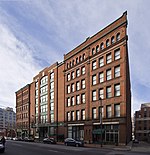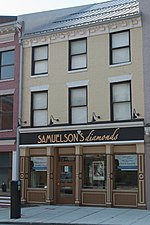Loft Historic District North

The Loft Historic District North is a national historic district in Baltimore, Maryland, United States. It includes 12 large 19th–early 20th century vertical brick manufacturing buildings centering on Paca, Redwood, and Eutaw Streets near the University of Maryland Campus in downtown Baltimore. Most of the buildings are still used for manufacturing purposes, although a few, including the Heiser, Rosenfeld, and Strauss buildings, have been converted into loft apartments or offices. They are representative of Romanesque, Victorian, and early modern industrial architectural design. It was in this area that Baltimore's garment industry grew to national importance.The Loft Historic District North was added to the National Register of Historic Places in 1985.
Excerpt from the Wikipedia article Loft Historic District North (License: CC BY-SA 3.0, Authors, Images).Loft Historic District North
West Redwood Street, Baltimore Downtown
Geographical coordinates (GPS) Address Nearby Places Show on map
Geographical coordinates (GPS)
| Latitude | Longitude |
|---|---|
| N 39.288333333333 ° | E -76.621944444444 ° |
Address
University of Maryland Professional Building
West Redwood Street 419
21201 Baltimore, Downtown
Maryland, United States
Open on Google Maps








